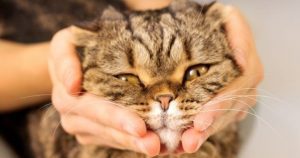 Weird Stuff
Weird Stuff  Weird Stuff
Weird Stuff  Movies and TV
Movies and TV Television’s Top Ten Most Ruthless Serial Killers
 Weird Stuff
Weird Stuff Ten of the Strangest Paraphilias Ever Documented
 Miscellaneous
Miscellaneous 10 Interesting Physics Facts about Bullets
 History
History 10 Oddest Naval Actions in History
 Music
Music 10 “Bands” That Are Actually Just One Person
 History
History Ten Uprisings Led by Women
 Creepy
Creepy Top Ten Creepiest Dolls in History
 Animals
Animals 10 Animal Actions You’ve Never Seen (Caught on Camera)
 Health
Health 10 Medical Treatments Your Doctor Probably Won’t Approve
 Weird Stuff
Weird Stuff 10 Reasons the Psychic Internet Theory Will Blow Your Mind
 Movies and TV
Movies and TV Television’s Top Ten Most Ruthless Serial Killers
 Weird Stuff
Weird Stuff Ten of the Strangest Paraphilias Ever Documented
Who's Behind Listverse?

Jamie Frater
Head Editor
Jamie founded Listverse due to an insatiable desire to share fascinating, obscure, and bizarre facts. He has been a guest speaker on numerous national radio and television stations and is a five time published author.
More About Us Miscellaneous
Miscellaneous 10 Interesting Physics Facts about Bullets
 History
History 10 Oddest Naval Actions in History
 Music
Music 10 “Bands” That Are Actually Just One Person
 History
History Ten Uprisings Led by Women
 Creepy
Creepy Top Ten Creepiest Dolls in History
 Animals
Animals 10 Animal Actions You’ve Never Seen (Caught on Camera)
 Health
Health 10 Medical Treatments Your Doctor Probably Won’t Approve
10 Fascinating Facts about Our Furry Feline Friends
Cats are impressive little creatures. Sure, they seem to have taken the internet by storm for years and won over the hearts of people who communicate and spend time online. And offline, they have a long and proud history as domesticated pets and refined at-home companions down through the ages. But of course, they are descended from and genetically linked to wild beasts like lions and tigers. So cats, while cute, have predatory instincts and some incredible adaptations that have been handed down over the ages.
In this list, we’ll take a look at ten of those interesting cat facts. These small, cuddly, (sometimes) lovable creatures are adorable and heartwarming. And they can also be hilariously prickly and passive-aggressive. But it all goes back to their amazing genetics. So, read on for the big rundown on why cats are the way they are—and how they came to be this way!
Related: Top 10 Amazing Prehistoric Creatures With Unexpected Adaptations
10 What’s in a Nose?

Every cat’s nose is unique. Just like a human fingerprint, a cat’s nose print has all sorts of unique individual patterns, bumps, ridges, and valleys that are only made up in that order and in that way for that cat—and no other cat on Earth! In fact, cat nose prints are so unique that they could theoretically be used to track cats and figure out which feline went where and did what.
Of course, we would need to somehow create a database of cat nose prints, just like we have a fingerprint database for human anti-crime and criminal justice efforts. And then we’d have to somehow ensure that every cat used their nose to touch things and leave markings, which isn’t always a given. And this would really only apply if cats were out there committing crimes or something. Which they’re not—at least, we hope they aren’t!
Jokes aside, though, it is true that you can identify every single cat on Earth by its unique nose print. Just like our fingerprints, their noses are like no other cat that is living or has ever lived, making them who they are, even if we can’t see it with the naked eye.[1]
9 The Wild World of Whiskers
Cats can fit into and through some pretty tiny spaces. You would think your friendly local feline is a little puffy or even a little fat, but they can contort their bodies in all kinds of ways and get through tight fits and around small openings. It’s almost like they know exactly how much space they need to get through a slender slot every time. And, in fact, they do!
Cats use their whiskers to gauge whether they can fit into and through narrow spaces. See, their whiskers are roughly as wide as their bodies, and when cats come up to a small or enclosed space, the feeling and sensation of their whiskers alert them to what is going on there. Consider their whiskers like radar in that regard—or even like a car’s backup camera!
That’s not the only way whiskers are used, either. Cats have exceptional distance vision and can spot things moving from far away. If you’ve ever seen your cat go up to the window and track birds outside for hours on end, you know this to be the case. They love to look out at their world and follow birds, dogs, and other objects from dozens or even hundreds of yards away. But up close, their vision isn’t as good. And that’s where their whiskers come in!
A cat’s whiskers act like a radar system in helping the animal “see” things right up close to them better. By brushing their whiskers against the object, they can figure out what something is and what they should do with it since their eyes don’t focus quite as well on things very, very near to them. In turn, their whiskers send information to their brains and keep everything processing quickly and efficiently.[2]
8 The Cat’s Meow
It isn’t very often that domestic house cats will meow at other cats. Instead, cats most typically have a variety of body movements meant to communicate with and get the attention of their peers. These can be as simple as various tail whippings, movements around, or body postures that let other cats know how a cat is feeling.
Anger, happiness, contentment, calm, and playful excitement can all be communicated through these various body movements between cats, according to scientists. But with humans? Well, we’re often not observant enough to pick up on these subtle body movements. And we need a little something more to draw our attention!
When it comes to interacting with humans, cats have learned to meow. See, wild felines like lions and tigers don’t meow like house cats do. Because of that notable difference, biologists believe domestic cats have evolved over thousands of years specifically to meow to their human counterparts. And their noises are subtle but important.
According to animal behaviorists, cats have a “vocabulary” of as many as a few dozen different meows. These meows are meant to alert humans if they are hungry, thirsty, or angry. While we don’t know cat language, of course, we can sometimes pick up on the timbre of their vocalizations and figure out what they need. And in that way, cats really do talk to us![3]
7 Back to Bed!
If you have a house cat at your place, you know there is one thing they do above everything else: sleep. And if it seems like your cat is constantly dozing off and enjoying a very lazy life, well, you’d be right. The typical house cat sleeps for about 70% of their lives.
On an average day, a cat sleeps anywhere from 12 to 16 hours off and on. But the reasons are more complicated than just the fact that your cat loves being lazy. Their sleep patterns have actually been dictated by millions of years of evolutionary biology!
See, cats are what is known as a “crepuscular” animal. That is a big, fancy word that basically means they are most active at both dawn and dusk. Going back thousands (well, really millions) of years, this is because their ancestors were active at those times hunting prey. Prey animals would typically only come out at dawn and dusk and avoid the middle of the day, and ancient cats learned to do the same.
Those evolutionary traits trickled down through the eons, and today, house cats have picked up on those same habits. Besides, the naps they take throughout the day aren’t done in one long swoop. Cats usually only sleep for 15-20 minutes at a time, opting for quick cat naps (hence the term!) before opening their eyes and seeing what’s happening.
In all, though, cats aren’t technically lazy. They are just conserving energy by sleeping all day and preparing themselves for the next time they get to hunt prey. At least, that’s what their genes are telling them to do![4]
6 Tons of Toes!
Cats usually have 18 toes, but they can sometimes have more—and occasionally many more! These types of cats are called “polydactyl” cats, and they are more common than you might think. A genetic abnormality that has been passed down through the ages causes certain cats to be born with extra toes on each foot. In some instances, those toes can even resemble human thumbs.
It’s a little weird, of course, but it’s actually considered to be a sign of good fortune and good luck. And the reason for that is the purpose of why polydactyl cats were prized throughout history. Centuries ago, cats were often brought on ships for long journeys across the ocean. Not only could they ferret out and eat rats and mice, but they were also good companions for sailors.
Surprisingly, polydactyl cats were especially prized because captains thought the rare felines had better balance during storms when the ship bobbed about in high waves. So ship captains across the Middle Ages and into the Golden Age of Sail looked for polydactyl cats to bring on board their boats. The Puritans also brought many polydactyl cats to the New World in the 17th Century. And their gene pool spread, making it more likely to encounter extra polydactyl cats through breeding.
Today, the Ernest Hemingway Home and Museum in Key West, Florida, is home to around 60 polydactyl cats. Hemingway was given one during his lifetime, and he loved it so much that it stayed around and had a ton of polydactyl babies. The cats who live on the museum grounds now make up one of the largest populations of polydactyl cats in one spot that animal biologists and behaviorists know about.
By the way, the world record for the most toes on a cat is 28. That mark belongs to two cats jointly—a Canadian cat named Jake and an American feline named Paws. Both were officially recognized by Guinness World Records as having an incredible 28 toes—ten more than those on a typical cat.[5]
5 Get the Terms Right!
A group of cats that hang out together is called a “clowder.” Perhaps that sounds like it should be some kind of soup, but it’s not! And if you want to be technical, a “clowder” is best reserved for a group of cats who know and trust each other. Suppose a group of cats is wary of each other and possibly will act aggressively toward one another. In that case, it’s technically correct to call those felines a “glaring.”
Kittens have proper names, too. Of course, you can call a group of newly-born kittens a “litter,” which is a term we are all pretty much aware of, we’d hope. But there is another more technical term for a group of kittens playing around and interacting together: a “kindle.” That word comes from the verb “to kindle,” which means to give birth to a group of young offspring. And, uh, we also suppose that in modern times, it means to read books on your e-reader, too.
There is one more critical cat term to know: “trichobezoar.” That’s a complicated-sounding word, but it really just is the technical term for a hairball. As many cat enthusiasts know, hairballs are pretty common for cats to suffer through.
And while we normal folk just call it a hairball every time our cat coughs up the phlegmy discharge, scientists call it a “trichobezoar,” to be technically correct. That word is rooted in “trich,” which means hair, and “bezoar,” the suffix for any foreign material obstructing a living creature’s intestines or digestion.[6]
4 Ditching the Collarbone
There’s an old saying about cats always landing on their feet, even if they fall from a very high elevation. But the years-old fact about cats being able to land foot-first isn’t just an old myth or a passed-down legend; it’s scientifically true!
Cats have a righting reflex that naturally allows them to orient themselves while jumping or falling. The reflex is a hereditary thing baked into their genes, and it begins to appear in kittens as young as 3-4 weeks old. By the time those kittens get to two-ish months old, they have pretty much perfected it. And the rest is history! Well, sort of.
In addition to the righting reflex, cats can land on their feet so naturally because they have no collarbones and a very, very flexible backbone. Unlike humans and many other animals, cats don’t have clavicles. This allows them to spin around very quickly and always make sure they are upright upon landing. This also allows them to fit into very, very tight spaces.
Have you ever wondered how your cat can get behind the washer and dryer or squeeze into other remarkably tight spaces? It’s because they can collapse their shoulders into an extremely tightly packed position. Without clavicles, they can squeeze into and out of tiny spaces that look like they shouldn’t be able to fit a full feline.[7]
3 The Catnip Conundrum
Cats tend to do very well with catnip. The potent substance (which is technically called Nepeta cataria, if we’re going by its scientific name) offers mood-altering effects for cats. It causes those who play in it to be mellow in many instances. In other instances, cats will get silly, energetic, carefree, or even happy just by being around catnip.
The leaves and stems of the substance contain something called nepetalactone. That’s an oil that is released naturally whenever the plant is crushed. Its scent, upon release, is picked up by a cat’s very strong sense of smell, producing mood-altering behavior inside the feline. The cat’s brain basically goes into a “feel-good” mood, as its receptors are linked to pheromones via the catnip response.
Unfortunately, not every cat responds well to catnip. In fact, a significant portion of cats don’t respond at all to the substance! The positive catnip response in cats is hereditary, and not all cats are affected by it. The latest science holds that more than half—and possibly as much as 70%—of cats do have a response to catnip. But that leaves at least 30% of all domesticated house cats without the gene to really feel the effects of Nepeta cataria!
It takes a while to come out in kittens, too. Most kittens need to be over three months of age, and some need to be over six months, in rare instances, to begin to feel the effects of catnip. But not all kittens will age into it, and roughly a third of all cats don’t care one way or another about it.[8]
2 An Extra Eyelid
While humans and many other animals have only two eyelids, cats actually have an extra third “secret” eyelid that helps them with a variety of things. We are used to our own eyelids, which are just upper and lower, and simply blink together every few seconds. They work to keep out dirt and dust and shield our eyes from things like bright lights and reflections.
But cats take it a step further with what is called a “haw,” or more technically, a “nictitating membrane.” Not only does that third horizontal eyelid keep cats’ eyes moist, but it also helps protect them against a variety of things that could harm the cat due to their curious and inquisitive nature of sticking their face into places it may not always belong.
The eyelid flaps in from the inner corner of the cat’s eye and crosses over its eye. You can see it most often when a sleepy cat slowly opens its eyes after a period of slumber. If you look quickly and carefully, as its eyes open, it’ll flash that third eyelid. Creepy!
Most of the time, you can’t really spot it easily, though, and in healthy eyes, it’s mostly hidden away when cats are looking around and being active. That’s not the only weird part of a cat’s eyes, though; they also have a reflective layer behind their retinas.
I’s called the “tapetum lucidum,” and it works to reflect light back through the retina to enhance night vision. If you’ve ever seen a cat’s eyes at night and wondered why they appear to glow in the dark and reflect even in low light, well, that’s why. And it’s also why cats can see so well after the sun goes down![9]
1 Super Senses
Cats should be seen as very impressive little creatures. The equivalent of superheroes, perhaps—at least as far as their senses go. In all senses, cats are extraordinary. They are far beyond humans in the capability of what their senses can do and even far beyond other animals.
For one, cats have an insanely strong sense of smell. They have about 200 million odor sensors in their tiny noses. Compared to humans, who have around five million odor sensors, cats are far and away better at sensing things by smell than us. They often open their mouth while smelling, too, to get an even better understanding of what it is they are analyzing with the hundreds of millions of sensors they have.
That’s not the only remarkable trait shared by all cats. Felines also have scent glands on their cheeks, paws, and at the base of their tails. They use these glands to rub up against other objects. The secretion given off by these glands allows cats to mark their territory, as it were. And if they rub up against people with their faces, that’s them marking you as their primary person!
Scent and smell aren’t the only ways that cats excel, though. Not only is their eyesight very good, as we’ve already learned (especially for long distances, evolved as a way to track prey), but their hearing is also exceptional and flexible. Cats can naturally rotate their ears up to 180 degrees around their head to accurately pinpoint exactly where a sound is coming from so they can figure out whether to fight or flee.[10]








